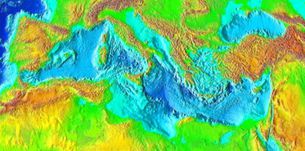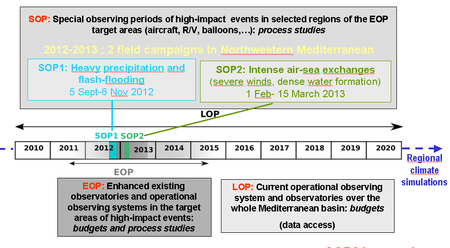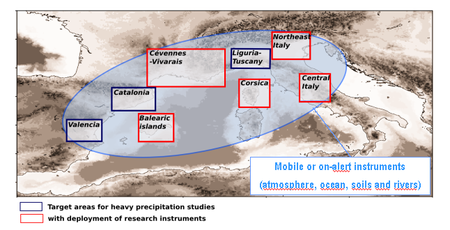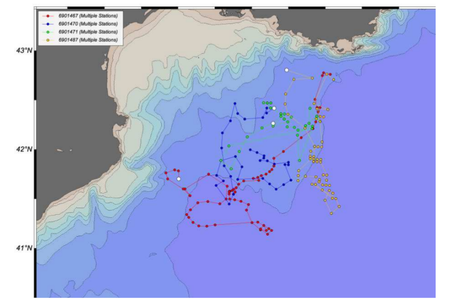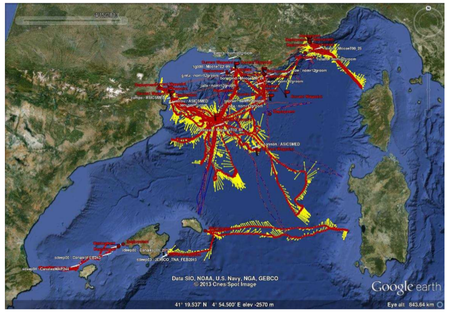HyMeX aims at a better understanding, quantification and modelling of the hydrological cycle in the Mediterranean, with emphasis on the predictability and evolution of extreme weather events, inter-annual to decadal variability of the Mediterranean coupled system, and associated trends in the context of global change.
HYdrological Cycle in the Mediterranean EXperiment
by V. Ducrocq* (a) and the HyMeX team
* Corresponding author : Veronique Ducrocq
(a) : GAME-CNRM (Météo-France & CNRS), Toulouse France
The hydrological cycle in the Mediterranean is a key environmental and socio-economic question for a wide region encompassing southern Europe, northern Africa and the Middle East. The lack of readiness and mitigation strategies could result in critical situations, in particular in case of extreme events and inadequate evaluation of climate change impacts. To face environmental challenges, progress has to be made in the understanding of the Mediterranean climate.
HyMeX (HYdrological cycle in the Mediterranean EXperiment) aims at a better understanding and quantification of the hydrological cycle and related processes in the Mediterranean, with emphasis on high-impact weather events, inter-annual to decadal variability of the Mediterranean coupled system, and associated trends in the context of global change. To reach these objectives, HyMex proposes to monitor and model the Mediterranean atmosphere-land-ocean coupled system, as well as the social vulnerability related to water resources and extreme event impacts. The variability of the system will be monitored from the event to the seasonal and interannual scales, and its characteristics over one decade (2010- 2020) in the context of global change.
Based on a French initiative carried out within the MISTRALS (Mediterranean Integrated Studies at Regional and Local Scales) metaprogram, HyMeX has developped an international partnership with about 400 scientists from twenty countries participating to the program.
Scientific objectives
The Mediterranean basin (fig.1) has quite a unique character that results both from physiographic conditions and historical and societal developments. The region features a nearly enclosed sea surrounded by very urbanized littorals and mountains from which numerous rivers originate. This results in many interactions and feedback between ocean-atmosphere-land processes that play a prominent role in climate and high-impact weather. The Mediterranean area actually concentrates the major natural risks related to the water cycle, including heavy precipitation and flash-flooding during the fall season, severe cyclogenesis associated with strong winds and large sea waves during winter, and heat waves and droughts accompanied by forest fires during summer. Such natural hazards highly impact the populations living in the area. The capability to predict such high-impact events remains weak because of the contribution of very fine-scale processes and their non-linear interactions with the larger scale processes.
Figure 1 : Geographical configuration of the Mediterranean Sea (source : HyMeX)
HyMeX should produce new long-term and highly temporaly and spatially resolved data-sets over the Mediterranean basin to :
- provide an accurate description of the water cycle and its variability and trend
- understand how the Mediterranean water cycle processes contribute to the regional climate
- validate the regional high resolution oceanic, atmospheric and hydrological models and develop improved parametrizations.
HyMeX should help at developing methodologies and models in synergy with the field campaign, in order to improve weather and seasonal prediction, regional climate studies, climate impact and environmental research. HyMeX science is thus organized along five major topics : hydrological continental cycle ; heavy precipitations and flash-flooding ; intense air-sea exchanges ; water budget of the Mediterranean Sea ; vulnerability and adaptation.
The observation strategy
The general observation strategy is based on a three-level nested observation scheme:
- A Long-term Observation Period (LOP, 2010-2020) is on-going to gather and provide observations on the whole coupled system in order to analyse the seasonal-to-interannual variability of the water cycle and to estimate the water budget. The LOP relies on the current operational observing systems and existing long-term observatories in hydrology, oceanography and meteorology, not excluding the set-up of additional networks. The LOP covers the whole Mediterranean basin, and is devoted to develop and maintain the acquisition of the long-term time series required to study seasonal and interannual variability.
- An Enhanced Observation Period (EOP 2012-2015) is foreseen for both budget and process studies. The EOP is envisaged to last at least 4 years, embracing the SOP periods (see fig.2). However EOP periods may cover specific parts of the year only, e.g. autumns for heavy precipitation, extending to winter for severe cyclogenesis and strong winds. The EOP is based on the enhancement of existing research observatories and operational observation networks.
- Special Observation Periods (SOPs) last several months, that aim at providing detailed and specific observations to study key processes of the water cycle in Target Areas (TA). In addition to the EOP observation framework, dedicated ground-based, shipborne and airborne means will be deployed during the SOPs.
Figure 2 : The observation strategy (source HyMeX)
The first HyMeX EOP/SOP series are conducted over the Northwestern Mediterranean :
SOP1
A first field campaign (SOP1) was dedicated to heavy precipitation and flash-flooding from 5 September to 6 November 2012. The 2-month field campaign took place over the Northwestern Mediterranean Sea and its surrounding coastal regions in France, Italy and Spain. The observation strategy aimed at monitoring four key components leading to heavy precipitation and flash-flooding in that region: (i) the marine atmospheric flow that transport moist and conditionaly unstable air towards the coasts; (ii) the Mediterranean Sea as a moisture and energy source; (iii) the dynamics and microphysics of the convective systems; (iv) the hydrological processes during flash-floods.
During the field campaign about twenty precipitation events were monitored. Three aircraft performed about 250 flight hours for a survey of the upstream flow, the air-sea fluxes and the convective systems. About 800 additional radiosoundings were launched either from HyMeX sites or from operational RS sites in Europe, as well as about 20 boundary layer balloons were launched to monitor the low-level flow over the Mediterranean Sea and the ambient atmospheric conditions. Gliders, Argo floats, drifting buoys and ocean soundings from vessels monitored the Mediterranean Sea during the field campaign. Atmospheric and hydrological instruments such as radars, LIDARS, radiometers, wind profilers, lightning sensors, were deployed over 5 regions in France, Italy and Spain.
Figure 3 : The SOP1 domain and sites (source : HyMeX)
SOP2
A second filed campaign (SOP2), from 1st February 15 March 2013 aimed to study dense water formation, ocean convection and intense air-sea exchanges. The experiment sought to describe in details the characteristics (spatial extension, temperature, salinity, current) of the zone of formation of dense waters and its exchanges with the atmospheric boundary layer. Seven gliders in turns scanned the area to make transects over the convection zone, 5 rapid-cycle argo floats funded by GMMC have been added to the fleet of 10 floats already on site together with a dozen marisondes and SVP drifting buoys.
During the field campaign, CTD and XBT measurements of ocean profiles were made by the research ship Le Suroit between the 2 and 22 February 2013 in the framework of the MISTRALS/MERMEX program and also during few days by the CNRS ship le Tethys II and the buoy tender Le Provence des Phares et Balises. Flux measurements by instrumented masts from the Ocarina platform and Le Provence were made, together with measurements of wave swell from Le Provence during its outings. One of the objectives of the campaign was also measurements of fluxes in the marine boundary layer by the ATR42 aircraft and wave swells using the Kuros radar in the framework of an associated CNES project. The atmospheric boundary layer was in addition sampled from some fifteen boundary layer balloons launched from the Montpellier area, radiosondes from the French coast and Le Provence and by the profilers network located along the French coastline, from Perpignan to the south of Corsica. The coordination centre of operations was located in the premises of the CNRM-GAME, where scientists had readily access to weather predictions from the AROME-WMED model dedicated to the HyMeX campaigns, to operational model from Météo-France and ECMWF, to ocean forecasts from Mercator-Océan PSY2 and IBI36 operational models, MARS3D model from Previmer and the SYMPHONIE research model from Laboratoire d'aérologie.
For this second HyMeX field campaign, mistral and tramontane winds were at the rendezvous, especially on 8 occasions during the month and a half of the duration of the field campaign. These conditions were propitious for the formation of dense waters and ocean convection mixing the whole ocean column in the Gulf of Lion.
Figure 4 : The trajectories during HyMeX SOP2 of the GMMC Argo floats performing 1-day rapid cycle.
Figure 5 : The trajectories of the 6 gliders deployed during SOP2
A unprecedent amount of physical-ocean observations has been collected during the two field campaigns. For instance, 28 deployments of gliders took place in Northwestern Mediterranean from September 2012 to April 2013 performing more than 4000 profiles (0-1000m) and measures of the average current during the dives. These datasets are provided to the CORIOLIS database as well as archived in the HyMeX database.
The EOP is on-going since summer 2012 to study a full annual cycle of dense water formation and spreading, and the hydrological response to heavy precipitation over the Cévennes-Vivarais watersheds each autumn.
The modelling strategy
The HyMeX modelling strategy associated with the observation strategy includes, among others :
- The development of regional coupled systems (ocean-atmosphere, land-atmosphere, ocean-land-atmosphere) to reduce uncertainties on the regional projections of future climate. The validation of such systems includes measuring thir capability to accurately simulate the Mediterranean water budget using the HyMeX multidisciplinary database.
- The improvement of convective-scale deterministic forecast systems to improve the prediction capabilities of Mediterranean high-impact weather events. HyMeX field campaigns should provide an unique high-resolution database to validate these new NWP systems: microphysical properties (polarimetric radars, aircraft measurements), marine boundary layer characteristics and air-sea fluxes measurements (buoys, research vessels), novel high-resolution moisture measurements (GPS delays on board ships, radar refractivity, water vapour from lidar, etc).
- The design of high-resolution ensemble modelling systems dedicated to the study of the predictability of Mediterranean heavy precipitation and severe cyclogenesis. Quantifying and rating the different sources of uncertainty at various scales that impact the forecast of Mediterranean intense events is one goal of HyMeX through the design of multiscale and nested ensemble forecast systems, possibly based on mesoscale ensemble data assimilation techniques.
- The coupling of these ensemble forecast systems with hydrological models to issue probabilistic forecast of the impact in terms of hydrological response. Advances in knowledge of the hydrological and hydraulic responses as well as of the soil water content state before and during the precipitation events should help to improve these hydrological models.
- The development of new process modelling, parameterization development, novel data assimilation systems for the different Earth compartments. For example, improvement of air-sea flux parameterizations or development of data assimilation in cloud and precipitation systems are major objectives of HyMeX and part of the observation strategy is designed to serve these objectives.
HyMeX partnership and endorsements
HyMeX is coordinated by Météo-France and CNRS and is currently funded by a large number of agencies, including CNRS, Météo-France, CNES, IRSTEA, INRA, ANR, Collectivité Territoriale de Corse, KIT, CNR, Université de Toulouse, Grenoble Universités, EUMETSAT, EUMETNET, AEMet, Université Blaise Pascal-Clermont Ferrand, Université de la Méditerranée Aix-Marseille II, Université Montpellier 2, CETEMPS, Protezione Civile Nazionale, Université Paris-Sud 11, IGN, EPFL, NASA, New Mexico-Tech, IFSTTAR, MERCATOR Ocean, NOAA, ENEA, TU Delft, CEA, ONERA, IMEDEA, SOCIB, ETH, MeteoCat, Consorzio LAMMA, IRD, National Observatory of Athens, Ministerio de Ciencia e Innovación, CIMA, BRGM, Wageningen University and Research center, University of Zagreb - Faculty of Geodesy, Split Institute of Oceanography and Fisheries, INGV, OGS, Maroc Météo, DHMZ, ARPA Piemonte, ARPA Emilia- Romagna, ARPA Calabria, ARPA Friuli-Venezia Giulia, ARPA Liguria, ISPRA, University of Connecticut, Università degli Studi dell'Aquila, Università di Bologna, Università degli Studi di Torino, Università degli Studi della Basilicata, Sapienza Università di Roma, Università degli Studi di Padova, Università del Salento, Universitat de Barcelona, Universitat de les Illes Balears, Universidad de Castilla - La Mancha, Universidad Complutense de Madrid, Meteo Swiss, DLR. It also received indirectly support from the the European Community’s Seventh Framework Research Programme through associated projects.
HYMEX research on the global hydrological cycle and prediction of its evolution is endorsed by the Global Energy and Water Cycle Experiment (GEWEX) of the World Climate Research Program (WCRP). HyMeX is endorsed by the Joint Scientific Committee (JSC) of the WWRP (World Weather Research Program), and more specifically by the WWRP-THORPEX program. HyMeX regional climate modelling activities contribute for the Mediterranean region (MED-CORDEX) to the Coordinated Downscaling Experiment (CORDEX) initiative of WCRP.
Interesting links
HYMEX home page : http://www.hymex.org
MISTRALS (Mediterranean Integrated STudies at Regional And Local Scales) : http://mistrals.insu.cnrs.fr/spip/?lang=en
MERMEX (Marine Ecosystems Response in the Mediterranean Experiment) : http://mermex.com.univ-mrs.fr/

